Derivatives of Logarithmic Functions
Finding the Derivative of \(\ln(x)\)
Let’s investigate how one can derive \(ln(x)\). Recall that exponentials cancel logs and vice-versa. Specifically, when \(x>0\), note:
$$e^{\ln(x)}=x$$
because the exponential cancels the log. Now, if our goal is to find \(\frac{d}{dx} \ln(x)\) we can compute it using what we already know about derivatives and also a little bit of algebra on the above equation. See steps below!
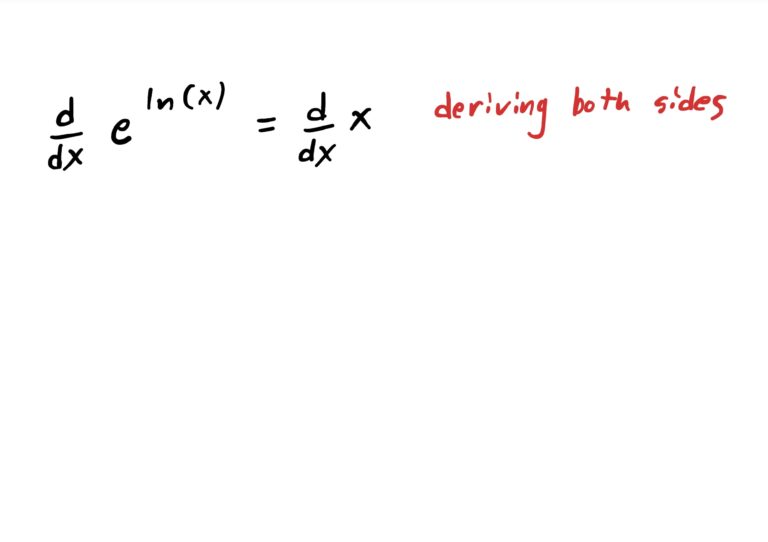
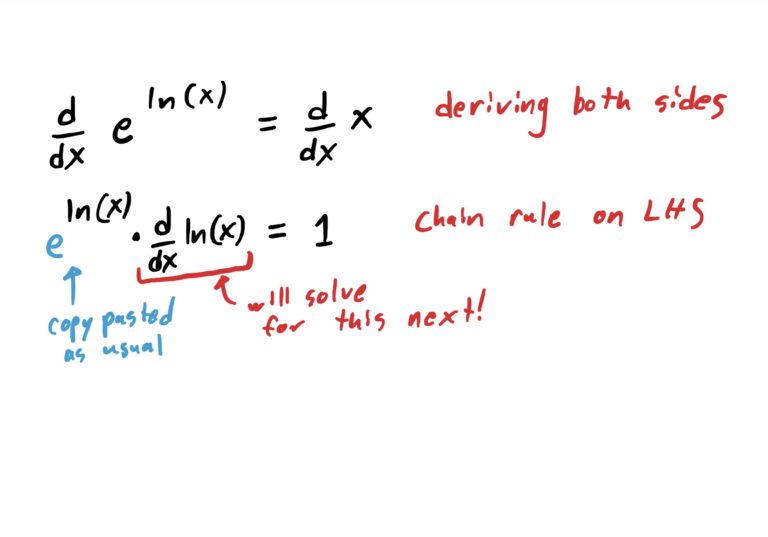
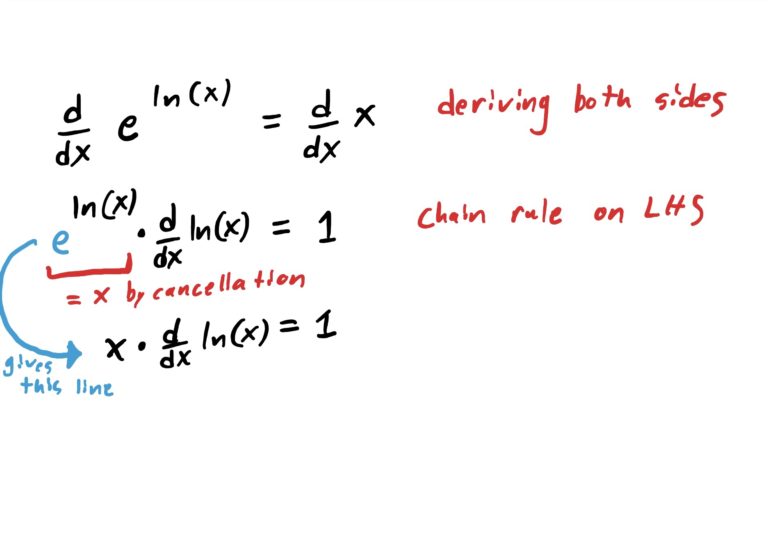
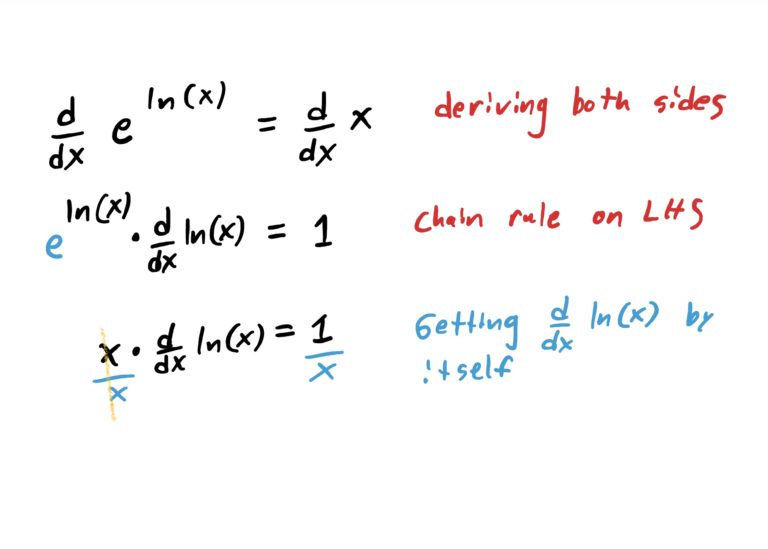
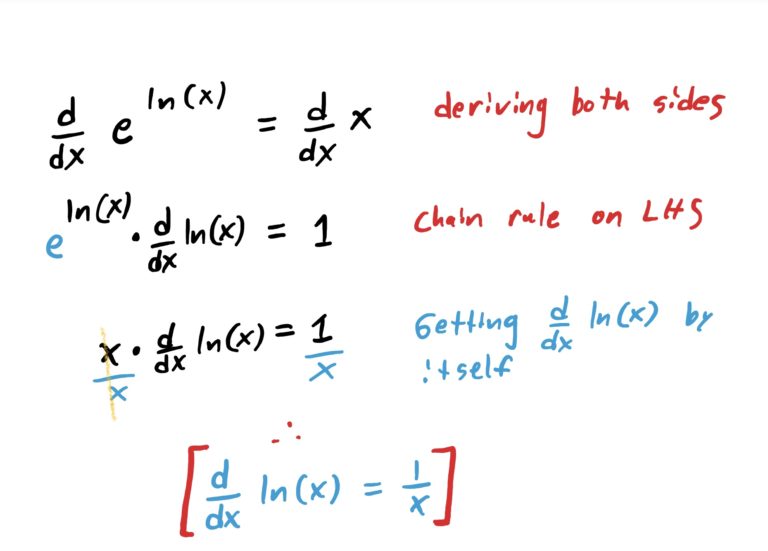
Deriving Logs with Stuff Inside
The above formula for the derivative of \(ln(x)\) also gives us a neat formula for computing derivatives of logs with (nontrivial) functions inside them if we employ the chain-rule.
As mentioned before, this rule comes entirely from the chain rule and the derivative of natural logs. The numerator in the rule above comes from multiplying by the derivative \(g’\) of the inside function \(g\), and the \(g(x)\) in the denominator is the original inside function that replaces \(x\) in the rule \(\frac{d}{dx}\ln(x)=\frac{1}{x}\).
Below is an example of how this log-chain-rule thing works in practice.
One can either use the chain rule idea here, or just use the formula. We will just use the formula. Find the derivative of the inside and put on top. Copy-paste the inside and put it in the denominator. That easy. Be below.
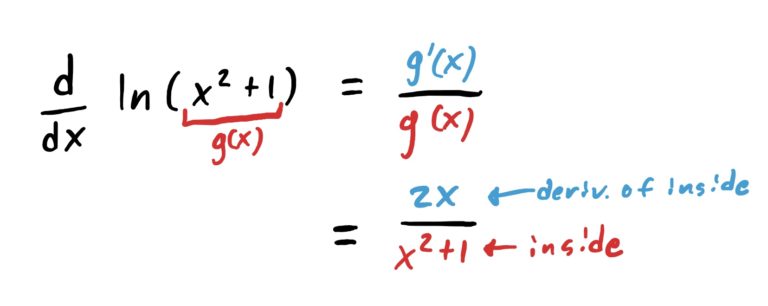
Deriving Non-Natural Logs
We can use the above rule to derive non-natural logs with stuff inside, like \(\log_2(x^3+2x-1)\). Here the base is \(2\) instead of \(e\). Thankfully, this doesn’t complicate things too much. We just hit it with the change-of-base formula.
In other words, we first use the change of base formula to convert the log to the natural log (which we know how to derive), noting that \(\ln(a)\) is just an ugly number that we more or less just carry along for the ride, and derive the natural log part as usual. All of this is demonstrated in the quick example below.
First we convert this log to a fraction of natural logs using the change-of-base formula.
$$\begin{align}\log_2(x^3+x^2-1)&=\frac{\ln(x^3+x^2-1)}{\ln(2)}\end{align}$$
Note that \(\ln(2)\) is just an ugly number. In fact, if it’s helpful to compute it’s decimal value (approximately), then do so. \(ln(2)=0.693147\). So we can now rewrite the above as
$$\begin{align}\frac{\ln(x^3+x^2-1)}{\ln(2)}&=\frac{\ln(x^3+x^2-1)}{0.693147}\\&=\frac{1}{0.693147}\cdot\ln(x^3+x^2-1)\\&=1.1442695\cdot \ln(x^3+x^2-1)\end{align}$$
Now we can take derivatives as usual using our rule for deriving logs, just carrying along that constant out in front until the end of the problem.
$$\begin{align}\frac{d}{dx}1.1442695\cdot \ln(x^3+x^2-1)&=1.1442695\cdot \frac{d}{dx} \ln(x^3+x^2-1)\\&=1.1442695 \frac{3x^2+2x}{x^3+x^2-1}\end{align}$$
Now, you can leave the answer as you see it above, or you can distribute that nasty decimal through the numerator. Up to you.
Again, the method is: convert the “unnatural” log using change-of-base, then derive it as usual.
Use the formula \(\frac{d}{dx}\ln(g(x))=\frac{g'(x)}{g(x)}\)
For deriving natural logarithmic functions \(\ln(g(x))\):
- copy/paste the inside of the log into the bottom of a fraction
- Derive the function inside the log and put it in the numerator of the fraction
Derivative of Natural Logs: \(\frac{d}{dx}\ln(g(x))=\frac{g'(x)}{g(x)}\)
\(\frac{d}{dx}\ln(x^2)=\frac{2}{x}\)
Use the formula \(\frac{d}{dx}\ln(g(x))=\frac{g'(x)}{g(x)}\)
For deriving natural logarithmic functions \(\ln(g(x))\):
- copy/paste the inside of the log into the bottom of a fraction
- Derive the function inside the log and put it in the numerator of the fraction
Derivative of Natural Logs: \(\frac{d}{dx}\ln(g(x))=\frac{g'(x)}{g(x)}\)
\(\frac{d}{dx} \ln(5x+3)=\frac{5}{5x+3}\)
First write the radical as a fractional power, then apply the method used for deriving logs
For deriving natural logarithmic functions \(\ln(g(x))\):
- copy/paste the inside of the log into the bottom of a fraction
- Derive the function inside the log and put it in the numerator of the fraction
Derivative of Natural Logs: \(\frac{d}{dx}\ln(g(x))=\frac{g'(x)}{g(x)}\)
\(\frac{d}{dx}\ln(\sqrt{x})=\frac{1}{2x}\)
Use change of base formula
- First apply Change-of-Base formula so you only have natural logs.
- Use the formula \(\frac{d}{dx} \ln(g(x))=\frac{g'(x)}{g(x)}\) to derive logarithmic functions, either directly, or along with other derivative rules (i.e. product, chain, quotient). Treat logs of numbers as constants and not functions.
- Derivative of Natural Logs: \(\frac{d}{dx}\ln(g(x))=\frac{g'(x)}{g(x)}\)
- Change-of-Base Formula: \(\log_b(a)=\frac{\ln(a)}{\ln(b)}\)
\(\frac{d}{dx} \log_2(x)=\frac{1}{x\ln(2)}\)
Use change of base formula
- First apply Change-of-Base formula so you only have natural logs.
- Use the formula \(\frac{d}{dx} \ln(g(x))=\frac{g'(x)}{g(x)}\) to derive logarithmic functions, either directly, or along with other derivative rules (i.e. product, chain, quotient). Treat logs of numbers as constants and not functions.
- Derivative of Natural Logs: \(\frac{d}{dx}\ln(g(x))=\frac{g'(x)}{g(x)}\)
- Change-of-Base Formula: \(\log_b(a)=\frac{\ln(a)}{\ln(b)}\)
\(\frac{d}{dx} \log_3(x^2+1)=\frac{2x}{(x^2+1)\ln(3)}\)
